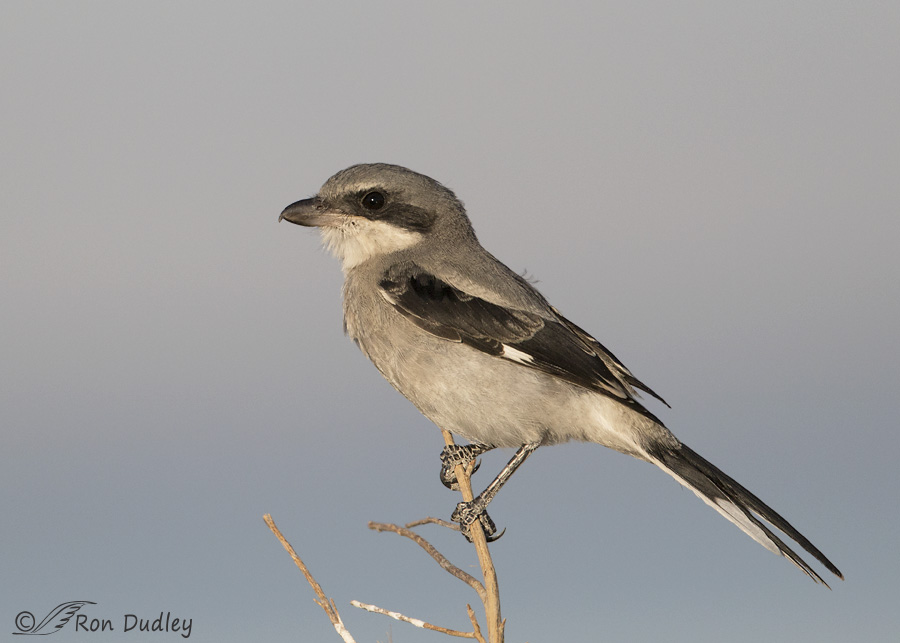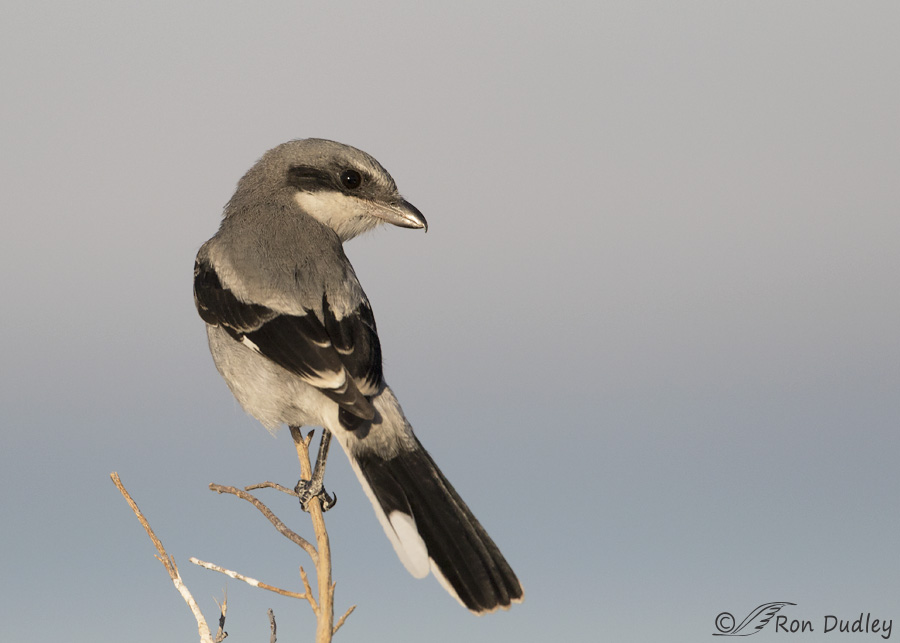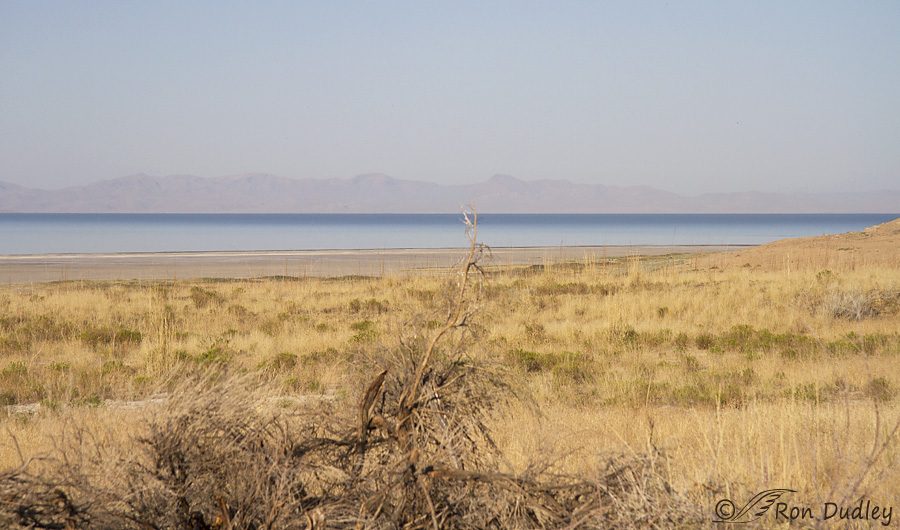Super-telephoto lenses can do a great job on the bird but they often leave the viewer clueless about habitat.

1/4000, f/6.3, ISO 500, Canon 7D Mark II, Canon EF 500mm f/4L IS II USM + EF 1.4 III Extender, not baited, set up or called in
I photographed this Loggerhead Shrike about six weeks ago on Antelope Island. The bird is sharp and has good detail, I had nice light and the background is clean. But the image is essentially a “bird on a stick” and provides the viewer little information about the setting/habitat because the perch is isolated from everything around it and the extremely shallow depth of field at these focal lengths leaves us mostly in the dark about what’s really in the background.
I’m not saying that’s necessarily a bad thing – in fact it has the advantage of helping the viewer to focus on the subject (fewer distractions) but it sure leaves us clueless about habitat.

1/3200, f/6.3, ISO 500, Canon 7D Mark II, Canon EF 500mm f/4L IS II USM + EF 1.4 III Extender, not baited, set up or called in
The shrike did give me another pose that I like but whenever I see an image like this I always wonder what’s really back there. Is it sky? Is it water? Could it be far away mountains? Or something else?

It was actually both water (an arm of the Great Salt Lake) and mountains and there may have even been a little sky, though the transition between mountains and sky is difficult to discern when it’s so blurred.
This photo, taken a few minutes after the shrike images and from very nearly the same angle, puts the perch into perspective in the habitat. I sometimes take photos like this because it allows me to recall the conditions when I photographed the bird and it reminds me that in the real world (as opposed to the false perspective of the original highly magnified image of the subject) the bird wasn’t isolated from its habitat at all.
So when I see one of my bird photographs taken long ago I can often mentally meld the bird with its habitat and that allows me to appreciate the image even more.
A little weird perhaps but it works for me…
Ron


The positive point of view, if the bird is in it’s habitat the viewer may appreciate the effort it took to “run down” the little guy.
Ron: I really like this concept. I fully agree that some type of sample of the bird’s habitat is important. I try to include a bit of the habitat in my bird photos for this reason. Thanks for illustrating this so well.
In my situation it’s a good habit to get in to, Lloyd. I don’t always remember or even have the opportunity though.
You know me, I’m all for twigs, shrubs, tree limbs and things. Love every time you show the habitat, or the bird in the habitat, all that is much appreciated.
I also love it when you are artistic and show the bird by itself – these are excellent images of a a Loggerhead, which would be a life bird for me.
You are such an excellent artisan that most mornings I revel with a cup of java, read your post and marvel at your images.
Many thanks for sharing!
Thanks so much for the kind words, Dick.
As a happy snapper, I love seeing the context. And revel in the detail that the shots you usually show us give. And taking photos of the context makes a heap of sense to me.
It makes sense to me too, EC. With as many images as I have in my files my memory needs all the help it can get!
When you are doing a portrait like these of the Shrike, it makes sense to not have a lot of stuff in the background. However, it’s also good to know what habitat you saw the bird in – it gives context and also is a reminder of who might be lurking just waiting for your camera to shoot them. I tend to like having context for the subject of my photos, but I use a point and shoot, and basically just take snapshots. Anything I get that’s really good is pretty much an accident and a very rare occurrence.
“also is a reminder of who might be lurking just waiting for your camera to shoot them”
Boy, isn’t that the truth! Can’t tell you how many wonderful shots I’ve missed because I was looking through my viewfinder using my telephoto lens and there was an even “better” bird only inches away that I didn’t even see. That actually happened to me several times this morning with both White-crowned Sparrows and American Pipits. Grrrr….
Very interesting. With that last image I get the notion of the distance between you and the bird(assuming that not only the angle was nearly the same but the distance was also the same). Am I right?
And this leads me to another question – how much do you crop your images? I guess it depends of the subject and the situation but I mean usually.
Your answer will help me to know if some photos are worth to be taken or not.
Hope all this makes sense to you.
Thank you for your time.
Jorge, Yes, both angle and distance were almost exactly the same in both.
I try very, very hard to avoid cropping much more than 50% of the original image. Any more than that and the price to be paid in image quality (detail, noise etc) is often just too high. I’ll sometimes crop more than 50% in interesting behavior shots though…
Even at very high f-stops, the depth of field at 700mm (500mm x 1.4TC) is measured in inches. A photographer is up against the laws of physics. Unless you want to indulge in Photoshop antics – photographing the background and then compositing the bird onto the background – habitat is lost in a shot like this. I think the over-the-shoulder shot is more interesting, but both shots demonstrate your impeccable technique and skill.
“A photographer is up against the laws of physics”
In SO many ways, WC. And those damn laws are hard to circumvent! Thank you for the kind words.
A note to other readers – WC and his wife (both good friends of mine) just returned from a two week trip to Peru and he took many wonderful images of exotic (to us) birds. He often posts them on his blog and you might want to peek in at them once in a while. His blog is eclectic (everything from birds to geology to politics and more), well written and intelligent. I highly recommend it.
https://wickershamsconscience.wordpress.com/
Alas, and we’re bound by ALL the laws of physics. Birds, on the other hand, are not. Only some of them pertain to birds!
“So when I see one of my bird photographs taken long ago I can often mentally meld the bird with its habitat and that allows me to appreciate the image even more.”
I get that. Despite the sheer number of images you’ve got in your files, I’m sure the context shots bring back your memory. It’s all in there somewhere, but if you’re like me, the where part can be problematic. When you anchor the memory with a contextual image, there it is!
Once again, thank you so much for your work. What a delightful way to begin the day! And loggerhead shrikes are among my favorite birds on the planet
Yup, this old guy’s memory often needs as much help as it can get, Laura. Shots like this last one can help with that!
Background “context” or not, I always enjoy the images you capture and seldom question where they’re taken.
Thank you, Patty.
It does depend on what you’re after. I’ve also noticed that sometimes there is something “missing” for me when I don’t have the context to put the creature I’m photographing in. I’ve never given it much conscious thought – I will now!
I’ve never given it much conscious thought – I will now!  Beautiful shots and thx for the commentary.
Beautiful shots and thx for the commentary.
“I’ve never given it much conscious thought – I will now!”
Good! Thank you, Judy.
Ron – great discussion. I guess it emphasizes the purpose of the photograph. As a photographer I assume your purpose is an artistic one. I am a Bird Watcer and use the photos I take for ID purposes. The first two pix would be heaven sent for me. The more scenic shot at that distant would be of little purpose. I guess that is one of the reasons I enjoy your blog posts so much. It is a great learning experience for me. Thanks!
Mark, For me that last shot would be of little purpose also, if it didn’t help me to visualize the setting of the shrike images when I’m looking at them. I think it sort of fills in some of the blanks…